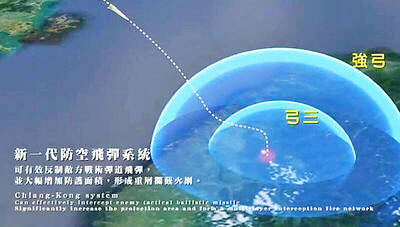China may be monitoring e-mails, cellphone calls and text messages to and from senior Taiwanese military officers, a new study from the Project 2049 Institute in Washington said.
The information gathered from the monitoring most likely goes to the Chinese Communist Party’s principal arm for political warfare, the study written by former Pentagon official Mark Stokes said.
He said it might facilitate assessment of individuals “with access and influence” for political purposes.
“These data collections are useful for evaluating and selecting officers for clandestine political warfare campaigns, among other functions,” Stokes said.
The study sheds new light on the Chinese People’s Liberation Army’s (PLA) General Staff Department (GSD) Third Department Second Bureau and its broad communications intelligence mission.
“The GSD Third Department, often referred to as 3PLA, is roughly analogous to the US National Security Agency,” Stokes said.
It has direct authority over 12 operational bureaus, three research institutes and a computing center. Eight of the 12 operational bureau headquarters are clustered in Beijing, two are based in Shanghai, one in Qingdao and one in Wuhan.
“The bureau allegedly maintains a data base on military officers from Taiwan, and presumably other foreign military personnel with a rank of colonel and above,” the study said.
“Profiles, updated on a semi-monthly basis, include basic data such as date and place of birth, education, personal habits, family and current location,” it said.
Stokes said that last year, the US indicted five PLA officers on charges of cyberespionage against US firms.
The five were assigned to the same group that is monitoring Taiwan military officers and that group appears to have “responsibilities well beyond cyberespionage.”
The Second Bureau oversees a work station in the vicinity of a major submarine cable landing station on Chongming Island and probably a unit near the Nanhui cable landing station.
“Second Bureau elements with direct access to fiber optic cable landing stations could buffer communications traffic entering and leaving China,” Stokes wrote.

LIMITS: While China increases military pressure on Taiwan and expands its use of cognitive warfare, it is unwilling to target tech supply chains, the report said US and Taiwan military officials have warned that the Chinese People’s Liberation Army (PLA) could implement a blockade within “a matter of hours” and need only “minimal conversion time” prior to an attack on Taiwan, a report released on Tuesday by the US Senate’s China Economic and Security Review Commission said. “While there is no indication that China is planning an imminent attack, the United States and its allies and partners can no longer assume that a Taiwan contingency is a distant possibility for which they would have ample time to prepare,” it said. The commission made the comments in its annual

DETERMINATION: Beijing’s actions toward Tokyo have drawn international attention, but would likely bolster regional coordination and defense networks, the report said Japanese Prime Minister Sanae Takaichi’s administration is likely to prioritize security reforms and deterrence in the face of recent “hybrid” threats from China, the National Security Bureau (NSB) said. The bureau made the assessment in a written report to the Legislative Yuan ahead of an oral report and questions-and-answers session at the legislature’s Foreign Affairs and National Defense Committee tomorrow. The key points of Japan’s security reforms would be to reinforce security cooperation with the US, including enhancing defense deployment in the first island chain, pushing forward the integrated command and operations of the Japan Self-Defense Forces and US Forces Japan, as

‘TROUBLEMAKER’: Most countries believe that it is China — rather than Taiwan — that is undermining regional peace and stability with its coercive tactics, the president said China should restrain itself and refrain from being a troublemaker that sabotages peace and stability in the Indo-Pacific region, President William Lai (賴清德) said yesterday. Lai made the remarks after China Coast Guard vessels sailed into disputed waters off the Senkaku Islands — known as the Diaoyutai Islands (釣魚台) in Taiwan — following a remark Japanese Prime Minister Sanae Takaichi made regarding Taiwan. Takaichi during a parliamentary session on Nov. 7 said that a “Taiwan contingency” involving a Chinese naval blockade could qualify as a “survival-threatening situation” for Japan, and trigger Tokyo’s deployment of its military for defense. Asked about the escalating tensions

INTERCEPTION: The 30km test ceiling shows that the CSIST is capable of producing missiles that could stop inbound missiles as they re-enter the atmosphere Recent missile tests by the Chungshan Institute of Science and Technology (CSIST) show that Taiwan’s missiles are capable of intercepting ballistic missiles as they re-enter the atmosphere and pose a significant deterrent to Chinese missile threats, former Hsiung Feng III missile development project chief engineer Chang Cheng (張誠) said yesterday. The military-affiliated institute has been conducting missile tests, believed to be related to Project Chiang Kung (強弓) at Pingtung County’s Jiupeng Military Base, with many tests deviating from past practices of setting restriction zones at “unlimited” and instead clearly stating a 30.48km range, Chang said. “Unlimited” restrictions zones for missile tests is